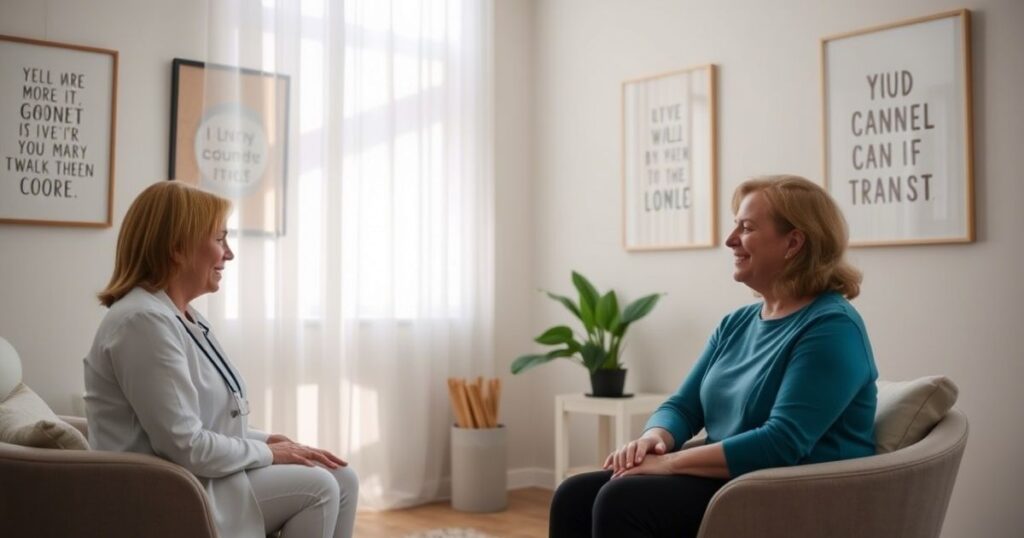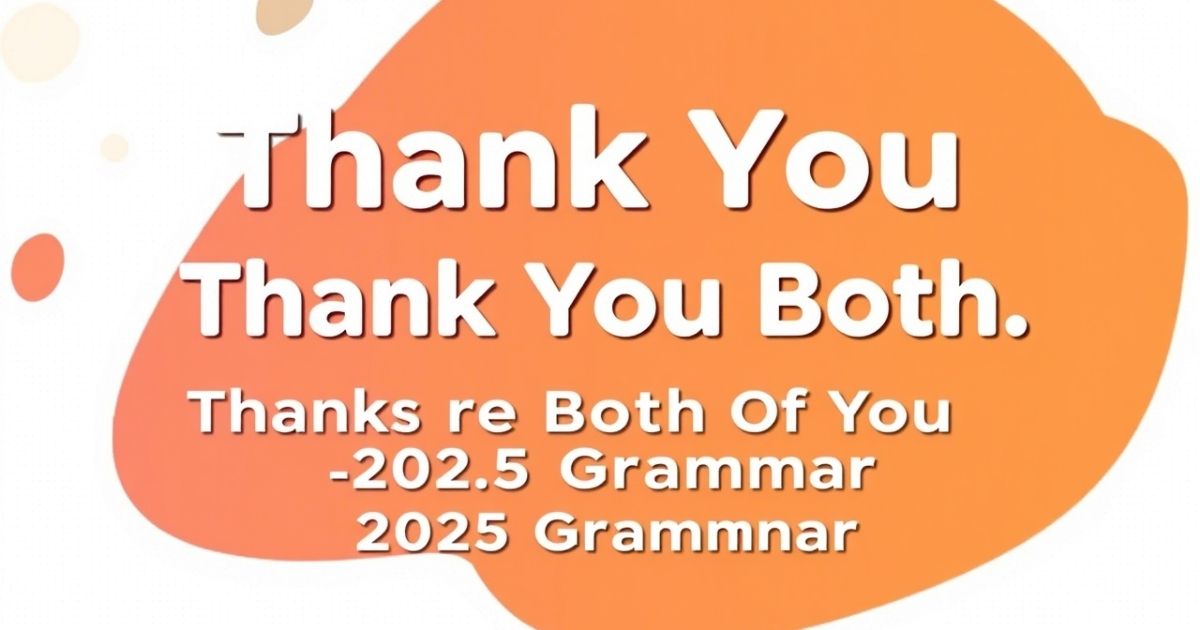Thanks to Both of You is a heartfelt expression of gratitude that shows appreciation for two individuals. Saying thanks to both of you allows you to acknowledge their efforts together. Whether it’s for help, support, or just a kind gesture, thank you both is a simple yet powerful way to show your thanks. Thanks to both helps to personalize the acknowledgment and makes the message more sincere.
When you say, “thanks to you both,” it’s a way to express gratitude directly to the two people involved. The phrase “thank you, both” can also be used interchangeably, and yes, is thank you both correct? Absolutely! Whether you say thanks to both or thank you both, the sentiment remains strong. It’s a lovely way to show appreciation and let others know their actions truly mattered. Thanks to both of you is a thoughtful way to express thanks with clarity.
Difference Between ‘Thank You Both’ or ‘Thanks to Both of You’?

When expressing gratitude to two people, you might find yourself choosing between phrases like “Thank you both” and “Thanks to both of you.” While both phrases communicate appreciation, there is a subtle difference in how they’re structured and used in conversation. Understanding this difference can help you decide which phrase fits best in any given situation.
“Thank you both” is a straightforward, more concise way to express thanks. It’s often used in a more casual or direct manner and can easily be used in both formal and informal contexts. This expression is efficient, making it an ideal choice when you want to show gratitude to two individuals in a quick, yet heartfelt manner.
On the other hand, “Thanks to both of you” tends to feel slightly more formal or deliberate. It can emphasize the specific actions or support provided by the two individuals, giving a more personal touch. This version of expressing gratitude might be preferred when you want to draw attention to their contributions more explicitly. Both phrases are correct, but understanding when and how to use each can enhance your ability to communicate gratitude effectively.
Here, I’m going to provide 30 sentences with the phrase “thank you both”
- “Thank you both for your assistance. It was invaluable.”
- “I wanted to express my gratitude to you both. Thank you!”
- “Thank you both for being there for me when I needed support.”
- “I couldn’t have done it without you. Thank you both!”
- “Your teamwork and dedication are greatly appreciated. Thank you both.”
- “Thank you both for going above and beyond to help me out.”
- “I’m so grateful for your help. Thank you both for everything.”
- “Your kindness means the world to me. Thank you both.”
- “I truly appreciate your support. Thank you both for being there.”
- “Thank you both for your patience and understanding during this time.”
- “I can’t thank you both enough for your hard work and commitment.”
- “Your generosity has made a huge difference. Thank you both so much.”
- “Thank you both for always making things easier for me.”
- “I’m so lucky to have you both in my corner. Thank you!”
- “Thank you both for your continued support throughout this project.”
- “I’m deeply grateful for all your efforts. Thank you both.”
- “Thank you both for your guidance and advice; it’s been invaluable.”
- “I couldn’t have asked for better help. Thank you both!”
- “Your contributions have been amazing. Thank you both from the bottom of my heart.”
- “Thank you both for your constant encouragement and positivity.”
- “I appreciate everything you’ve done for me. Thank you both!”
- “Thank you both for your unwavering support and kindness.”
- “Your assistance has been incredible. Thank you both so much.”
- “I’m extremely thankful for everything you both did to help me.”
- “Thank you both for making this experience so much smoother for me.”
- “I truly appreciate how much you both have helped me. Thank you.”
- “Thank you both for your quick response and thoughtful solutions.”
- “I feel so lucky to have both of you in my life. Thank you!”
- “Your teamwork has been amazing. Thank you both for your effort.”
- “Thank you both for always being so reliable and helpful.”
Here are 30 sentences with the phrase “thanks to both of you”
- “Thanks to both of you, everything went smoothly.”
- “I couldn’t have done it without you. Thanks to both of you.”
- “Thanks to both of you for your time and effort.”
- “Thanks to both of you for the amazing support you provided.”
- “Everything turned out great, and it’s all thanks to both of you.”
- “I’m so grateful to both of you for your help with this project.”
- “Thanks to both of you, I was able to get through this challenging time.”
- “I really appreciate everything you’ve done. Thanks to both of you!”
- “Thanks to both of you, the event was a huge success.”
- “Thanks to both of you for being so patient and understanding.”
- “I couldn’t have finished the task without you. Thanks to both of you!”
- “Thanks to both of you, we were able to meet the deadline.”
- “I owe it all to you. Thanks to both of you for your dedication.”
- “Thanks to both of you for going above and beyond to help me.”
- “I’m deeply thankful for your support. Thanks to both of you.”
- “Thanks to both of you, I’ve learned so much throughout this process.”
- “Thanks to both of you, I now have everything I need to move forward.”
- “You both made a huge difference. Thanks to both of you!”
- “Thanks to both of you, the project was completed on time and perfectly.”
- “Thanks to both of you for your teamwork and collaboration.”
- “I’m so glad to have you both on my team. Thanks to both of you!”
- “Thanks to both of you, the issue was resolved quickly and efficiently.”
- “I can’t express how grateful I am. Thanks to both of you.”
- “Thanks to both of you, everything was organized and went as planned.”
- “I couldn’t have asked for better help. Thanks to both of you!”
- “Thanks to both of you, I feel more confident moving forward.”
- “The outcome was fantastic, and that’s thanks to both of you.”
- “Thanks to both of you for making this such a pleasant experience.”
- “Thanks to both of you, I’m feeling much better about the situation.”
- “I truly appreciate everything. Thanks to both of you for your kindness.”
Basic Definition
“Thanks” is a simple, informal expression used to show gratitude or appreciation for something someone has done. It is commonly used in everyday conversations to acknowledge a kind gesture, help, or favor, and is often employed in casual settings.
Though informal, “thanks” is universally understood and helps foster positive communication, whether in personal relationships or professional exchanges. It’s a quick and effective way to convey appreciation without the need for elaborate words or phrases.
Contextual Understanding
- Casual Conversations: “Thanks” is typically used in informal settings, such as casual chats with friends, family, or colleagues. It’s a quick and easy way to express appreciation without needing a formal tone.
- Widely Recognized: “Thanks” is universally understood in English-speaking cultures, making it a common expression of gratitude. While cultural variations in formal expressions of thanks exist, “thanks” remains a standard, informal way of acknowledging kindness or assistance.
Emotional Significance
- Strengthening Relationships: Saying “thanks” shows appreciation, which can help to strengthen personal and professional relationships by fostering goodwill and positive feelings.
- Acknowledging Effort: When you say “thanks,” it acknowledges that someone has taken time or effort to assist you, which can make the other person feel valued and recognized.
Variations and Forms
- Simple to Extended Phrases: “Thanks” can be extended into phrases like “thank you very much” or “thanks a lot” to emphasize greater appreciation or gratitude.
- Cultural Differences: While “thanks” is common, different cultures or regions may have their own variations, such as “merci” in French or “gracias” in Spanish, reflecting local customs in expressing gratitude.
Use Cases
- Daily Conversations: “Thanks” is often used in everyday situations, such as after receiving help, a gift, or a compliment, to acknowledge the action or kindness.
- Workplace Etiquette: In professional environments, “thanks” is frequently used to express appreciation for colleagues’ assistance, projects, or support, helping to maintain a positive work atmosphere.
Politeness and Etiquette
- Social Courtesy: Saying “thanks” is an essential part of polite communication, signaling respect and consideration for others’ time, effort, or kindness.
- Formality in Speech: Depending on the situation, using “thank you” instead of just “thanks” adds a layer of formality, making the interaction more professional and courteous.
Cultural Significance
- Global Expression: Gratitude, expressed through phrases like “thanks,” transcends borders, as most cultures have their own ways of showing appreciation, which strengthens social bonds.
- Varied Customs: The importance and formality of expressing thanks vary across cultures, with some cultures viewing gratitude as an essential social obligation, while others may view it as a more casual gesture.
Psychological Effects
- Positive Reinforcement: Expressing thanks can create positive reinforcement, encouraging the other person to continue their helpful behaviors, thus strengthening relationships.
- Emotional Well-Being: Saying “thanks” can boost the well-being of both the person expressing gratitude and the recipient, promoting feelings of happiness, contentment, and mutual respect.
Communication
- Clear Intentions: Using “thanks” communicates the speaker’s appreciation clearly and succinctly, reducing any ambiguity about the intentions behind the action.
- Non-Verbal Cues: Often paired with non-verbal cues like a smile or a handshake, “thanks” reinforces the sincerity of the gratitude and helps foster deeper emotional connection.
Related Guide:
Top 160 Commonly Used Verbs That Start With Z [2025]
Frequency and Usage
- Everyday Interactions: “Thanks” is a common part of daily conversation, used frequently in both personal and professional settings to acknowledge small acts of kindness.
- Context-Dependent: The frequency and manner of using “thanks” can depend on the situation, with people using it more often in informal settings and more formally in professional or formal contexts.
Situational Usage
- Casual Conversations: “Thanks” is often used in informal settings, such as when someone holds the door open for you or passes you an item, indicating appreciation in day-to-day interactions.
- Formal Settings: In more professional contexts, “thank you” or “thank you very much” is used to express gratitude in a more respectful and formal manner, such as in workplace environments or during interviews.
Reflexive Aspect
- Self-Recognition: The act of saying “thanks” can also serve a reflective function, helping the speaker acknowledge the value of the help or gift they have received, reinforcing positive behaviors.
- Automatic Response: In many situations, saying “thanks” becomes a reflexive action, something people do almost instinctively when they receive help, assistance, or a compliment, making it a social norm.
Limitation
- Overuse: If “thanks” is used too frequently or in contexts where it isn’t meaningful, it can lose its sincerity and fail to communicate genuine appreciation, making it seem routine.
- Lack of Depth: In some situations, a more detailed or specific expression of gratitude, such as “I truly appreciate your help with this project,” may be more impactful than a simple “thanks.”
Conclusion
- Acknowledgment of Effort: Despite its simplicity, saying “thanks” effectively acknowledges the effort or kindness of others, contributing to stronger social bonds and positive exchanges.
- Universal Gesture: “Thanks” is universally recognized and appreciated, making it a versatile and important tool for expressing gratitude in both personal and professional interactions.
Psychological Perspective

- Emotional Impact: Expressing thanks triggers positive emotions in both the giver and the receiver, creating a sense of satisfaction, warmth, and mutual respect.
- Gratitude’s Role in Well-Being: Regularly expressing thanks contributes to mental well-being, fostering positive relationships and emotional health by reinforcing feelings of appreciation and connectedness.
Meaning of ‘Both’
“Both” is a pronoun used to refer to two people, things, or groups considered together. It highlights the inclusion of two elements and is used to show that something applies equally to both items or individuals. For example, “Both of you did a great job.”
In grammatical terms, “both” can function as a determiner, pronoun, or conjunction, depending on the context. It is commonly followed by a plural noun or a pair of nouns to indicate two items together. Example: “Both the cat and the dog are sleeping.”
When used in comparison, “both” emphasizes the equality or shared quality of two subjects. It suggests that each element has the same characteristics or value. For instance, “Both options are good choices.”
“Both” can also express a sense of duality, referring to two sides, opinions, or approaches. It is often used to show that something is considered from two different perspectives or applies in two distinct situations. Example: “Both sides of the argument have valid points.”
“Both” can be used in both casual and formal conversations, making it versatile. In informal speech, it can be a quick way to refer to two people or things. In more formal contexts, it might be used to reinforce equality or inclusion. Example: “Both candidates presented strong proposals.”
“Both” appears in many idiomatic expressions and phrases to emphasize inclusion or joint action. Phrases like “both hands on deck” or “both feet on the ground” use “both” to refer to dual involvement or balance. Example: “He was involved in both projects.”
‘Thanks to’ as an Idiom
The phrase “thanks to” is often used as an idiom to express gratitude for someone or something that contributed to a positive outcome. For instance, if your friend helped you complete a difficult task, you might say:
- Thanks to my friend, I was able to finish the project on time.
If you wanted to thank both friends involved, you might say: - Thanks to both of you, I finished the project ahead of schedule.
This phrase can also be used in situations where the outcome is due to something other than a person. For example, after getting help from a new app, you might say:
- Thanks to the app, I was able to find my way to the event.
In a sarcastic tone, if you were late because of a delayed train, you might say: - Thanks to the train, I missed my meeting.
Expressing Thank a Group of More than Two People
When expressing thanks to a group of more than two people, it’s important to acknowledge everyone involved while keeping the tone inclusive and genuine. Here are a few ways to do this:
- Thanks to all of you – This is a straightforward and warm way to show gratitude. For example:
“Thanks to all of you, the event was a huge success!” - Thank you all – A simple and direct expression. Example:
“Thank you all for your hard work in making this happen.” - Thanks to everyone – This can be used when referring to a larger group, whether it’s colleagues, friends, or family. Example:
“Thanks to everyone, we were able to raise enough money for the charity.” - I appreciate all of you – This shows personal appreciation and acknowledges the collective efforts of the group. Example:
“I appreciate all of you for contributing to the project’s success.” - I’m grateful to everyone – A more formal yet still inclusive way to express thanks to a group. Example:
“I’m grateful to everyone who participated in the meeting today.”
Each of these expressions conveys gratitude to a larger group, highlighting the collective effort that contributed to a positive outcome.
Alternatives for Thank You

Here are some alternatives for “thank you” that can add variety to your expressions of gratitude:
- Thanks – A casual and common variation of “thank you.”
Example: “Thanks for your help!” - Much appreciated – A slightly more formal way to express gratitude.
Example: “Much appreciated for the support you’ve given me.” - I’m grateful – A heartfelt way to convey deep appreciation.
Example: “I’m grateful for your time and effort.” - Thanks a lot – A casual and slightly more emphatic version of “thanks.”
Example: “Thanks a lot for picking me up!” - I can’t thank you enough – A way to show that words can’t fully express your gratitude.
Example: “I can’t thank you enough for helping me through this.”
These alternatives can be used in different contexts, ranging from casual to formal, and allow you to vary your expressions of gratitude while keeping them genuine.
FAQ’s
Is it thanks to you both or thank you both?
Both phrases are correct, but they’re used in different contexts. “Thanks to both of you” feels more formal, while “thank you both” is more casual.
Which is correct: “To the both of you” or “To both of you”?
“Thanks to both of you” is the correct form. Adding “the” makes the sentence sound awkward, so it’s better to omit it.
How should I express gratitude to two people?
You can say “thanks to both of you” when expressing gratitude formally. It acknowledges the effort of two people while keeping the tone polite.
Can I use “thanks to both of you” in informal situations?
Yes, “thanks to both of you” can be used informally. It still sounds respectful while being casual enough for friends or colleagues in everyday conversations.
What is the difference between “thanks to you both” and “thank you both”?
“Thanks to both of you” highlights the collective effort of two people, while “thank you both” is a simpler, more direct way of expressing gratitude.
Conclusion
Saying “Thanks to both of you” is a meaningful way to express gratitude to two people for their help or support. When you say “thanks to both “, you’re acknowledging the effort of each person, which makes your appreciation feel personal and heartfelt. It’s important to know that both “thank you, both” and “thank you both” are also correct ways to express thanks, depending on the context. So, when you’re unsure about phrasing, remember that “thanks to both “ works perfectly in most situations.
“Thanks to both “ helps convey gratitude in a clear and thoughtful manner. Whether you’re saying “thanks to you both” or “thank you, both,” these expressions all communicate appreciation to two people. If you ever wondered “is thank you both correct?”, the answer is yes! So, next time you need to show appreciation, “thanks to both of you” is a simple yet powerful way to do it.

Zion Blaze is a dedicated administrator with 5 years of experience in managing operations, optimizing workflows, and ensuring efficiency. Skilled in leadership, problem-solving, and team coordination.

